Bitte geben Sie einen Grund für die Verwarnung an
Der Grund erscheint unter dem Beitrag.Bei einer weiteren Verwarnung wird das Mitglied automatisch gesperrt.
Physis - Hauptwerk - Live und Nobilis - Klangqualität - Unterschiede
Meine bisherigen Erkenntnisse:
Vor dem Entscheid nach der Concerto 234 eine 3-manualige Orgel anzuschaffen, habe ich mich auch mit Johannus Live und Nobilis, sowie mit verschiedenen Hauptwerklösungen auseinander gesetzt.
Wieder fiel der Entscheid zu Gunsten der Physis-Technologie aus - Concerto 350 Trend. Warum?
Ich hatte mit Physis nie Konfigurationsprobleme. Sämtliche Software-updates und eigene, und importierte Konfigurationen funktionieren von Anfang (2014) an bis heute unverändert!
Wenn ich die Beiträge der Probleme mit HW-updates und neuen Windows-Versionen im Forum vergleiche, zeichnet sich Physis durch Stabilität aus. Meine Orgel klingt immer, wie ich sie zuletzt konfiguriert habe.
Mit Physis kann ich fast jederzeit klanglich so viel verändern, wie ich will. Natürlich ist damit ein nicht zu unterschätzender Zeitaufwand verbunden.
Aktuell dient meine Concerto 350 vor allem als Übungsinstrument, um die Musikliteratur als Teilzeit-Organist in drei Kirchgemeinden seriös vorzubereiten - klangliche Nuancen werden dann am jeweiligen Dienstinstrument umgesetzt, können aber auf der Concerto sehr gut simuliert werden.
Ich beschäftige mich seit längerem mit einer möglichst optimalen, externen Abstrahlung - ist aber bezogen auf individuelle Raumverhältnisse wirklich komplex - eine tolle Lösung habe ich (noch) nicht gefunden.
So kann ich meine aktuellen, persönlichen Bedürfnisse abdecken, und halte mir die Möglichkeit offen - falls ich mal genügend Zeit habe - die Möglichkeiten von Physis im Detail auszuloten.
Trotzdem interessant, was sich im digitalen Sakralorgelbereich weiterhin tut...
LG
Martin
 NAKOrgler
(
gelöscht
)
#2 RE: Physis - Hauptwerk - Live und Nobilis - Klangqualität - Unterschiede
NAKOrgler
(
gelöscht
)
#2 RE: Physis - Hauptwerk - Live und Nobilis - Klangqualität - Unterschiede
 NAKOrgler
(
gelöscht
)
NAKOrgler
(
gelöscht
)
Zitat von mvn im Beitrag #1
Wenn ich die Beiträge der Probleme mit HW-updates und neuen Windows-Versionen im Forum vergleiche
Ich habe Windows und Hauptwerk IV zusammen vor Jahren installiert. Dann HW V, dann HW VI. Das Windows läuft unverändert stabil. Keine Updates (kein Internet), keine Probleme.
Wenn jemand meint, er müsste jedes Betriebssystem-Update installieren, dann muss man Probleme und Anpassungsarbeiten einkalkulieren.
#3 RE: Physis - Hauptwerk - Live und Nobilis - Klangqualität - Unterschiede
Zitat von NAKOrgler im Beitrag #2
Wenn jemand meint, er müsste jedes Betriebssystem-Update installieren, dann muss man Probleme und Anpassungsarbeiten einkalkulieren.
Dem würde ich aus eigener Erfahrung widersprechen. Auf meinem privaten PC hatte ich seit Windows XP nie Probleme aufgrund von Betriebssystem-Updates. Allerdings gehöre ich definitiv nicht zu den Early-Adoptern und werde beispielsweise bezüglich des Windows 11-Upgrades warten, bis dieses offiziell von Hauptwerk und meinem Audio-Interface unterstützt wird. Hauptwerk nutze ich seit Version V und habe seitdem einige Halbjahres-Updates von Windows 10 sowie den ganz normalen regulären monatlichen Update-Reigen mitgemacht.

#4 RE: Physis - Hauptwerk - Live und Nobilis - Klangqualität - Unterschiede
Hallo zusammen,
ich bin mir sehr unsicher, ob es zielführend ist, hier wieder einen neuen Thread aufzumachen, um zum x-ten Mal zu erörtern, welches DO-Konzept das Beste sei und warum. Die jeweiligen Loblieder auf die jeweiligen Lieblingsinstrumente sind doch mittlerweile ausreichend gesungen worden. Physis ist toll, Hauptwerk natürlich auch, und Live/Nobilis sowieso :-)
VG
Stephan
#5 RE: Physis - Hauptwerk - Live und Nobilis - Klangqualität - Unterschiede
Zitat von mvn im Beitrag #1
Ich beschäftige mich seit längerem mit einer möglichst optimalen, externen Abstrahlung - ist aber bezogen auf individuelle Raumverhältnisse wirklich komplex - eine tolle Lösung habe ich (noch) nicht gefunden.
I can try to answer, but referring to the Physis organs that I know quite well.
I have no hardware knowledge of Live to apply the following examples to this instrument.
The main question is: what is missing from the built-in diffusion that needs additional external amplification? Is it possible to improve the internal amplification to avoid adding additional audio channels?
First of all, I must make a premise: the sound diffusion of the Sonus series is not trivial and also uses solutions that in my opinion are interesting.
For example, some channels have a digital active crossover, which is a smart solution in my opinion, and has many advantages in terms of reducing distortion due to passive components (i.e. capacitors and inductances).
There are some things that can be further refined to achieve even better internal reproduction, and thus achieve greater transparency and precision in reproduction.
The Sonus series has a variable number of channels from 7 (for the smaller models) to 9.
The bass channel (loaded in bass reflex and tuned to about 34 hz in the Sonus 40-60) has active low pass xover, and the surround and presence channels have an active high pass.
The channels under the pants have an electronic high pass, and, for the horn tweeters, an additional high pass provided by capacitors.
These 8 capacitors are mounted on the base board of the modular amplifier (C12/19)
In 7-channel models, these capacitors are electrolytic, while in 9-channel models they are polyester.
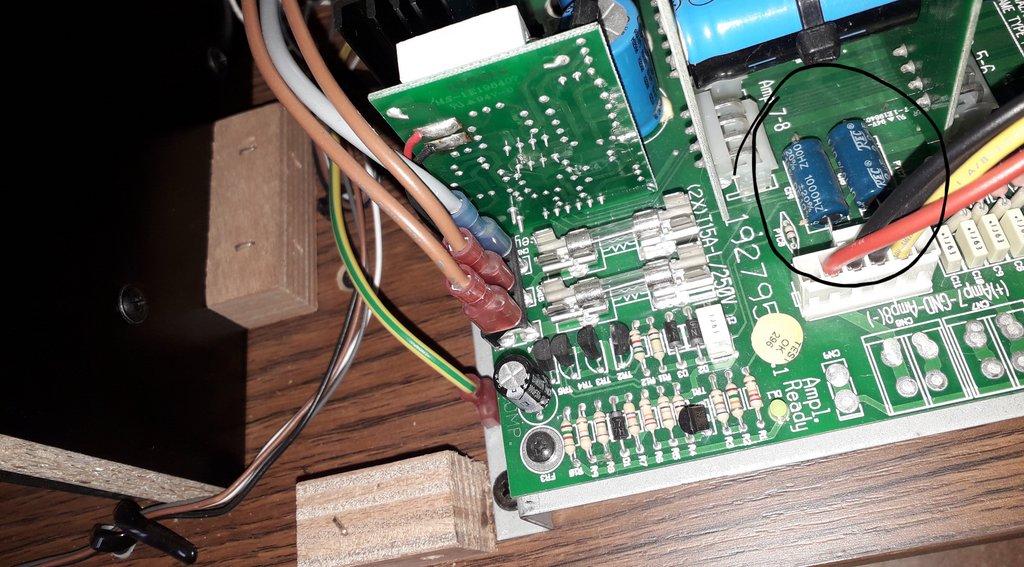
So the Sonus 40/45/50/235/346 have electrolytic capacitors (2.2uf, 63V, 20%), which are qualitatively lower than those made of polyester.
The replacement of these capacitors (I put them in polypropylene with 10% tolerance, they cost a few euros), produces less distortion and the effect is immediately audible. Greater cleaning of the high frequencies.
Of course, to replace them you need to have manual skills in knowing how to weld.
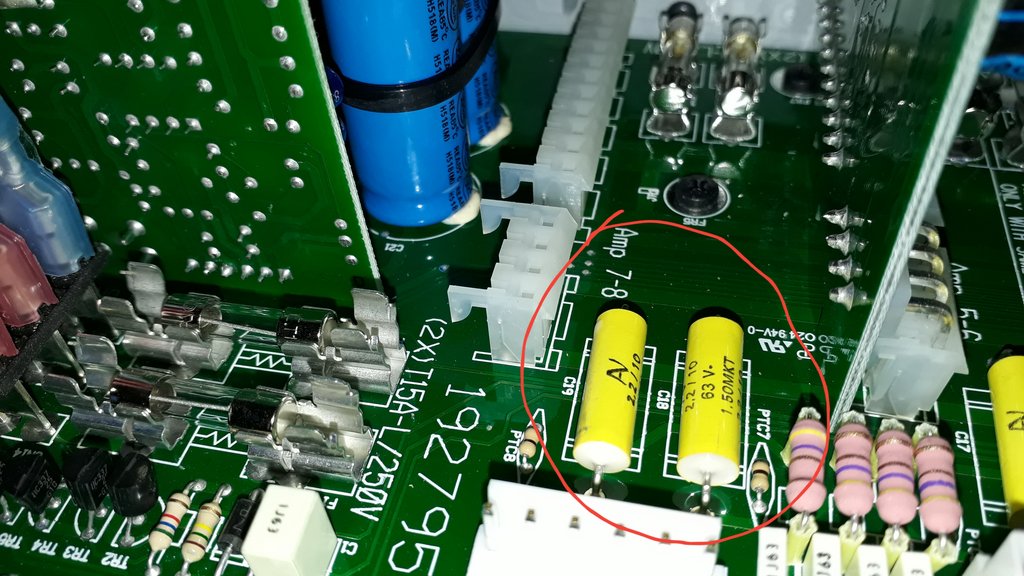
There are other refinements that can be achieved, without weld.
In the amplifier, the large filter capacitors (they are in pairs, blue, in the vertical boards), can be mechanically damped to prevent vibrations (external or self-induced) from producing distortion.
Many companies that build audiophile amplifiers are very familiar with this problem and solve it by mechanically damping the large capacitors, applying latches.
I applied a rubber strip between the pairs of capacitors of each board and then tied them with zip ties.
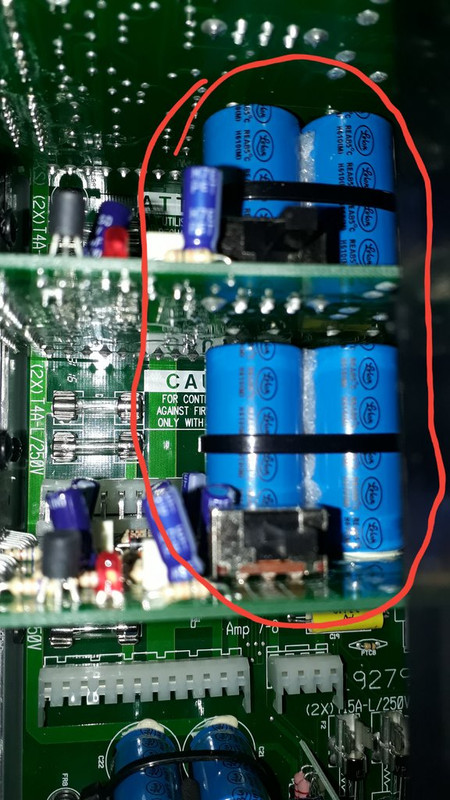
The cables that power the amplifier (those coming out of the toroidal transformer) can be twisted to further increase immunity to disturbances.
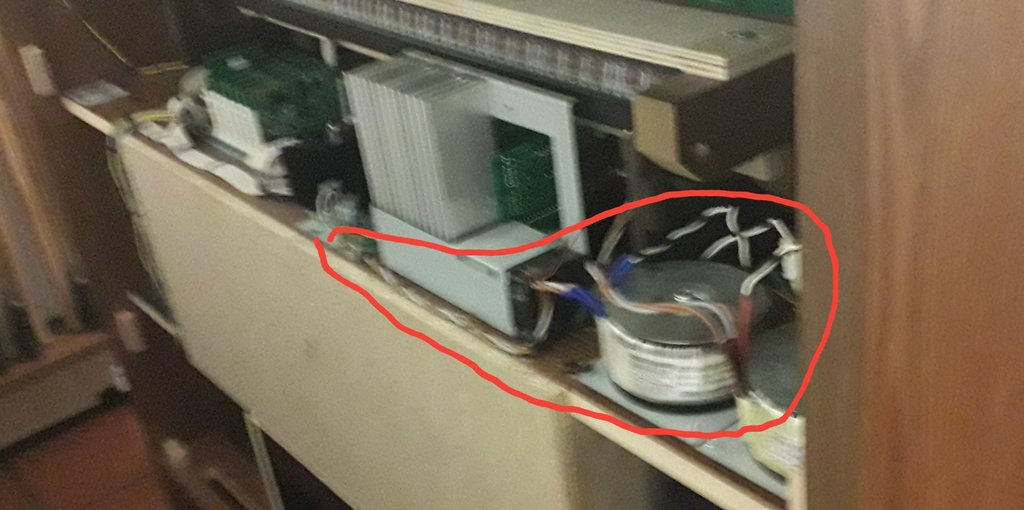
Finally, in the side compartments that house the side and front speakers, there may be sound-absorbing material depending on the model.
In the Sonus 40/45/50 there is sound absorbing material.
There is none in the Sonus 60. There are partly technical and partly commercial reasons behind this choice.
Well, buy a 50x50x3cm ashlar sound-absorbing panel. (It is important that it is exactly this thickness)

Cut out two strips 20cm wide, keeping the length of 50cm.
For 40/45/50 models remove the original white sound absorber and insert the strip, folded in an L, so that the embossed part is in front of the side speaker.
For the Sonus 60, the original sound absorber is not present, so place the new strips directly as explained above.
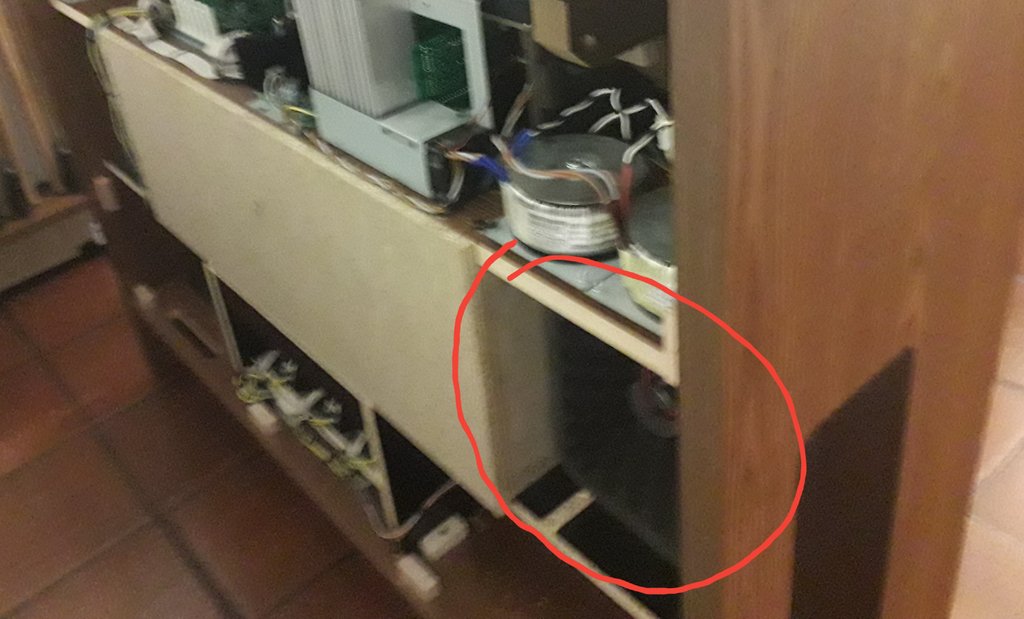
This simple change produces a very audible change.
 NAKOrgler
(
gelöscht
)
#6 RE: Physis - Hauptwerk - Live und Nobilis - Klangqualität - Unterschiede
NAKOrgler
(
gelöscht
)
#6 RE: Physis - Hauptwerk - Live und Nobilis - Klangqualität - Unterschiede
 NAKOrgler
(
gelöscht
)
NAKOrgler
(
gelöscht
)
Zitat von trompetendulzian im Beitrag #3
Dem würde ich aus eigener Erfahrung widersprechen.
Das darfst du
 Das Risiko bleibt.
Das Risiko bleibt. Bis zur Herstellerfreigabe warten, ist nicht verkehrt. Das Win11 fühlt sich bis auf Menü und Menüleiste unten fast wie ein Win10 an. Das wird vermutlich keine Probleme machen.
#7 RE: Physis - Hauptwerk - Live und Nobilis - Klangqualität - Unterschiede
 DigitalPipes
(
gelöscht
)
#8 RE: Physis - Hauptwerk - Live und Nobilis - Klangqualität - Unterschiede
DigitalPipes
(
gelöscht
)
#8 RE: Physis - Hauptwerk - Live und Nobilis - Klangqualität - Unterschiede
 DigitalPipes
(
gelöscht
)
DigitalPipes
(
gelöscht
)
Zitat von ahlborn im Beitrag #5Zitat von mvn im Beitrag #1
Ich beschäftige mich seit längerem mit einer möglichst optimalen, externen Abstrahlung - ist aber bezogen auf individuelle Raumverhältnisse wirklich komplex - eine tolle Lösung habe ich (noch) nicht gefunden.
I can try to answer, but referring to the Physis organs that I know quite well.
I have no hardware knowledge of Live to apply the following examples to this instrument.
The main question is: what is missing from the built-in diffusion that needs additional external amplification? Is it possible to improve the internal amplification to avoid adding additional audio channels?
First of all, I must make a premise: the sound diffusion of the Sonus series is not trivial and also uses solutions that in my opinion are interesting.
For example, some channels have a digital active crossover, which is a smart solution in my opinion, and has many advantages in terms of reducing distortion due to passive components (i.e. capacitors and inductances).
There are some things that can be further refined to achieve even better internal reproduction, and thus achieve greater transparency and precision in reproduction.
The Sonus series has a variable number of channels from 7 (for the smaller models) to 9.
The bass channel (loaded in bass reflex and tuned to about 34 hz in the Sonus 40-60) has active low pass xover, and the surround and presence channels have an active high pass.
The channels under the pants have an electronic high pass, and, for the horn tweeters, an additional high pass provided by capacitors.
These 8 capacitors are mounted on the base board of the modular amplifier (C12/19)
In 7-channel models, these capacitors are electrolytic, while in 9-channel models they are polyester.
So the Sonus 40/45/50/235/346 have electrolytic capacitors (2.2uf, 63V, 20%), which are qualitatively lower than those made of polyester.
The replacement of these capacitors (I put them in polypropylene with 10% tolerance, they cost a few euros), produces less distortion and the effect is immediately audible. Greater cleaning of the high frequencies.
Of course, to replace them you need to have manual skills in knowing how to weld.
There are other refinements that can be achieved, without weld.
In the amplifier, the large filter capacitors (they are in pairs, blue, in the vertical boards), can be mechanically damped to prevent vibrations (external or self-induced) from producing distortion.
Many companies that build audiophile amplifiers are very familiar with this problem and solve it by mechanically damping the large capacitors, applying latches.
I applied a rubber strip between the pairs of capacitors of each board and then tied them with zip ties.
The cables that power the amplifier (those coming out of the toroidal transformer) can be twisted to further increase immunity to disturbances.
Finally, in the side compartments that house the side and front speakers, there may be sound-absorbing material depending on the model.
In the Sonus 40/45/50 there is sound absorbing material.
There is none in the Sonus 60. There are partly technical and partly commercial reasons behind this choice.
Well, buy a 50x50x3cm ashlar sound-absorbing panel. (It is important that it is exactly this thickness)
Cut out two strips 20cm wide, keeping the length of 50cm.
For 40/45/50 models remove the original white sound absorber and insert the strip, folded in an L, so that the embossed part is in front of the side speaker.
For the Sonus 60, the original sound absorber is not present, so place the new strips directly as explained above.
This simple change produces a very audible change.
WOW! I love this kind of tuning! Reminds me of a TV show called "pimp my ride" where passionate car owners were heavily tuning their cars! We should call this "pimp my pipe!" :D
#9 RE: Physis - Hauptwerk - Live und Nobilis - Klangqualität - Unterschiede
 DigitalPipes
(
gelöscht
)
#10 RE: Physis - Hauptwerk - Live und Nobilis - Klangqualität - Unterschiede
DigitalPipes
(
gelöscht
)
#10 RE: Physis - Hauptwerk - Live und Nobilis - Klangqualität - Unterschiede
 DigitalPipes
(
gelöscht
)
DigitalPipes
(
gelöscht
)
Zitat von ahlborn im Beitrag #9
In fact, I like them too.. as an audiophile and I always try to get the maximum performance from each device.
The analog circuitry of the Sonus is already of a good standard, and with little work you can get a good improvement in audio performance!
Would be nice to have a digital output too though... ;)
(e scommetto che cambieresti il crossover anche alle Magneplanar!!! :D )
#11 RE: Physis - Hauptwerk - Live und Nobilis - Klangqualität - Unterschiede
Actually... there is. A "SPDIF out" track arrives at the DAC board which, however, at least in the Sonus 40/60 dac board is not connected. I have no idea if carry a stream of stereo, or compressed multichannel audio. I don't even know if it's software enabled.
But the fact that it exists makes me think it could be used in some way: perhaps for custom models like Regent.
Have you tried asking Viscount if there is a dac board with digital outputs? Maybe they have it available..
For the Magneplanar.. I don't own them, but I seem to remember that some models had good crossover components! :D
My loudspeakers (which I love, Opera Quinta 2011) have a crossover that I haven't modified! :-)
#12 RE: Physis - Hauptwerk - Live und Nobilis - Klangqualität - Unterschiede
Ich habe den von Ahlborn gebrachten Vorschlag aufgegriffen und Akustikschaum zwischen die Lautsprecher an der Seite und die anderen Lautsprecher meiner Concerto 350 eingebracht.
Nachdem ich aus den Fotos nicht so recht schlau geworden bin, musste ich nach dem Text gehen, den ich so verstanden habe, wie es auf meinen Fotos unten zu sehen ist.
Ich kann das Ergebnis aber bestätigen: Der Klang verbessert sich deutlich.
Viele Grüße
Stephan
IMG20211127110947.jpg - Bild entfernt (keine Rechte)IMG20211127110953.jpg - Bild entfernt (keine Rechte)
#13 RE: Physis - Hauptwerk - Live und Nobilis - Klangqualität - Unterschiede
Glückwunsch! Mit einem Materialeinsatz von ein paar Euronen eine wesentliche Verbesserung zu erzielen, ist ein absoluter Volltreffer. Unser findiger Mitforist Ahlborn sollte sich das patentieren lassen - oder in Mondaino mit diesem Verbesserungsvorschlag einkommen, der den Leuten dort eine satte Gratifikation wert sein sollte ...
LG
Michael
#14 RE: Physis - Hauptwerk - Live und Nobilis - Klangqualität - Unterschiede
I am happy that you have positively experienced this small modification!
In my case and for my environment I used less sound adsorber, but in any case if the result satisfies you it means that it's okay!
also try to put some bluetack around the big capacitors of the amplifiers, and to twist the cables coming out of the toroidal transformers...
I recommend instead not to add any sound absorbers inside the woofer cabinet. Adding absorbing material lowers efficiency. Whenever I tried to insert material, or to tune the resonant frequency to a lower frequency (by lengthening the reflex tube), I always came back preferring the original situation..
#15 RE: Physis - Hauptwerk - Live und Nobilis - Klangqualität - Unterschiede
Zitat von ahlborn im Beitrag #14
also try to put some bluetack around the big capacitors of the amplifiers, and to twist the cables coming out of the toroidal transformers...
I think that's valuable advice, too -- although it makes me wonder why that's not done by design at the factory in the first place, during construction. After all, I can't imagine that the average owner of a digital organ will have a good background in electrical engineering ;)
And if people can cough up an extra 300 for an adjustable music rack, they'll probably be fine with an extra 10 for the good capacitors (if using the good capacitors and not charging extra for them would ruin the company, that is :D)
Jetzt anmelden!
Jetzt registrieren!



